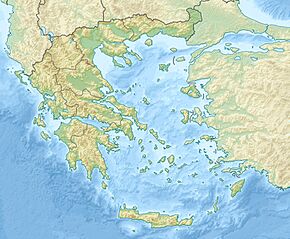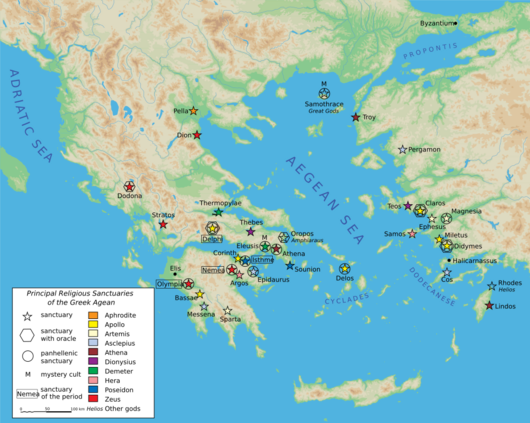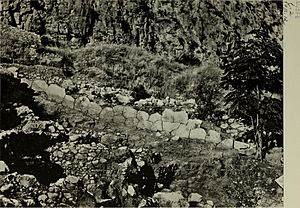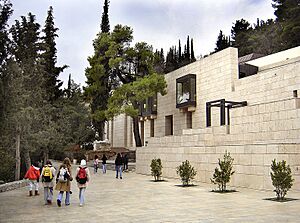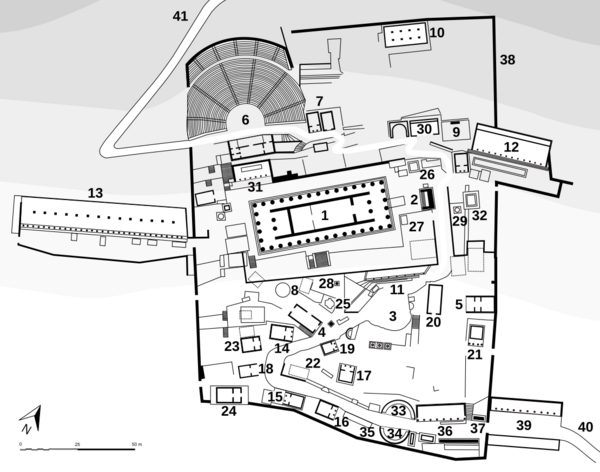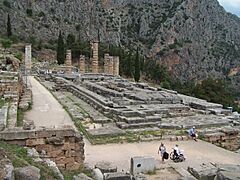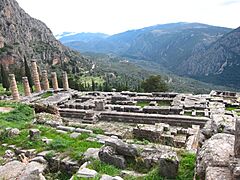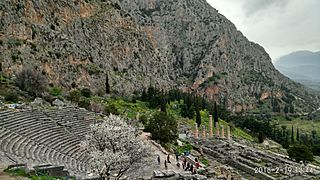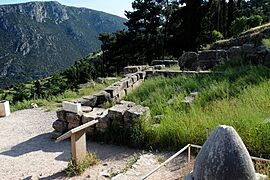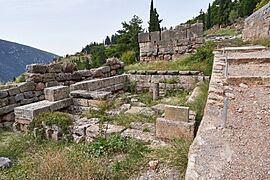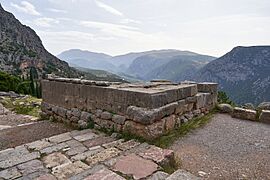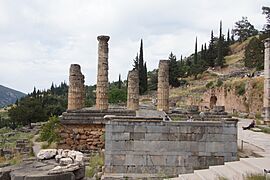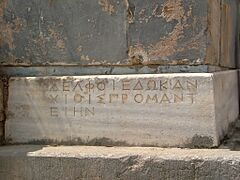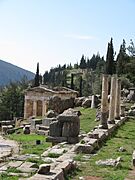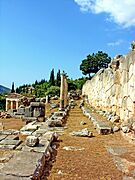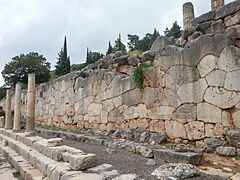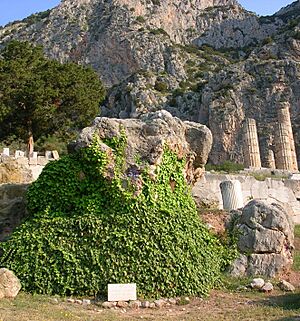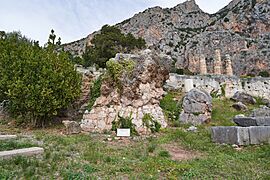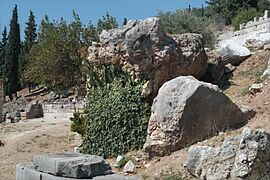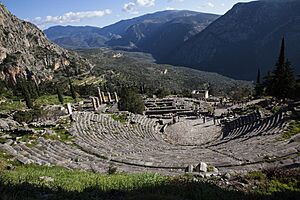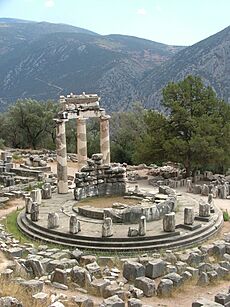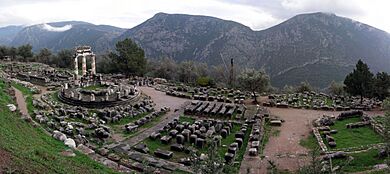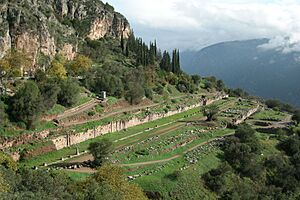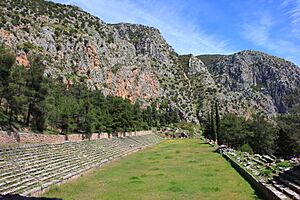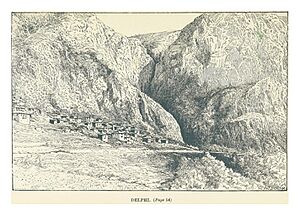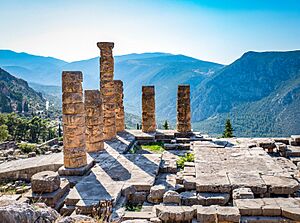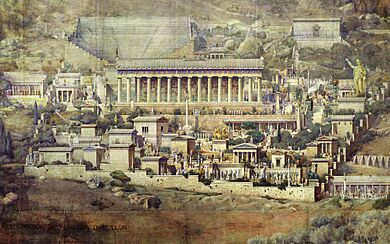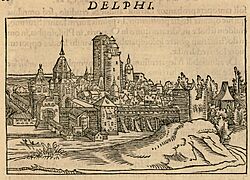Delphi facts for kids
|
Δελφοί
|
|

The Athena temple complex, including the Delphic Tholos. The background is the Pleistos River Valley.
|
|
| Location | Phocis, Greece |
|---|---|
| Coordinates | 38°28′56″N 22°30′05″E / 38.4823°N 22.5013°E |
| Type | Ruins of an ancient sacred precinct |
| Height | Top of a scarp 500 metres (1,600 ft) maximum off the valley floor |
| History | |
| Cultures | Ancient Greece |
| Site notes | |
| Archaeologists | French School at Athens |
| Ownership | Hellenic Republic |
| Management | Ministry of Culture and Sports |
| Public access | Accessible for a fee |
| Official name | Archaeological Site of Delphi |
| Type | Cultural |
| Criteria | i, ii, iii, iv and vi |
| Designated | 1987 (12th session) |
| Reference no. | 393 |
| Region | Europe |
Delphi is an ancient sacred place in Greece. It was home to the famous Pythia, also known as the oracle of Apollo. People from all over the ancient world came here for advice on important decisions. The ancient Greeks believed Delphi was the center of the world. A special stone monument called the Omphalos of Delphi marked this spot.
Delphi is located on the side of Mount Parnassus. Today, it is a large archaeological site. It is also part of Parnassos National Park. UNESCO has named Delphi a World Heritage Site. This shows how important it was in ancient times. Many Greek city-states built monuments here. This showed their shared Greek culture. A small modern town, also called Delphi, is next to the ancient site.
Contents
What's in a Name?
The name Delphi is linked to the Greek word delphys, which means "womb." This might connect to the idea of the omphalos stone being the "navel" of the world.
Another ancient name for the site was Pytho. This name is related to Pythia, the priestess who gave prophecies. It is also linked to Python, a giant serpent or dragon. This creature was said to live at the site. The word "Python" comes from a Greek verb meaning "to rot."
Where is Delphi Located?
Today, Delphi is both a municipality and a modern town in Greece. The modern town was built after the old village was moved. This allowed archaeologists to dig up the ancient site. Both the old and new Delphi are on Greek National Road 48. This road runs between Amfissa and Livadeia.
The area is in a valley formed by the Pleistos River. This river flows from east to west. It creates a natural path through the mountains. To the west, the valley connects to another valley. This one runs between Amfissa and Itea.
Long ago, a powerful city called Krisa controlled this valley. It was a strong city during the Mycenaean period. Early findings at Delphi suggest it was once part of Krisa's territory. The ruins of Kirra, near Itea, were likely Krisa's ancient port.
Discovering Ancient Delphi
Archaeologists first started digging at Delphi in 1880. A French team led by Bernard Haussoullier began the work. At that time, a village called Kastri stood on top of the ancient ruins. The villagers used stones from the old buildings for their own homes.
It was hard to start a full excavation because the village was in the way. But then, an earthquake badly damaged Kastri. The villagers were offered a new village in exchange for moving. In 1893, the French Archaeological School began a huge excavation. They removed tons of soil. This revealed the main buildings of the sanctuary of Apollo and Athena. They also found thousands of objects, writings, and statues.
During these digs, they found parts of a Christian church from the 5th century. Other important Roman buildings were also found. These included baths, a large house, the Roman Agora, and a big water tank. Old cemeteries were found outside the city.
A large building called the Southeastern Mansion was found. It had a long front and four levels. It contained private baths and storage jars. A tiny leopard made of mother-of-pearl was found there. It is now in the Delphi Archaeological Museum. This mansion was a private home until about 580 AD. Then, it became a pottery workshop. Around the 6th century, the city began to shrink. Its trade with other places also decreased. Local pottery was made in large amounts. It was rougher and reddish, made for the people living there.
The Sacred Way remained the main street. But it became a place for shops and workshops. Houses were mostly in the western part of the settlement. Two large water tanks provided water to these homes.
Delphi Archaeological Museum
The Delphi Archaeological Museum displays many amazing items from ancient Delphi. You can see the oldest known musical notes here. There is also the famous Charioteer of Delphi statue. Other highlights include the statues of Kleobis and Biton. Golden treasures found under the Sacred Way are also on display. You can also see the Sphinx of Naxos and parts of reliefs from the Siphnian Treasury.
Buildings of the Sacred Site
Most of the ruins you see today are from the 6th century BC. This was a very busy time for the site.
Temple of Apollo
Ancient stories tell of several temples built here. One was made of olive branches. Another was built by bees using beeswax and wings. A third was built by the gods Hephaestus and Athena. The first temple found by archaeologists was built in the 7th century BC. It burned down in 548 BC. A new one was built, but it also burned down in the 4th century BC.
The ruins of the Temple of Apollo visible today are from the 4th century BC. It was a Doric style building. It had columns all around it.
Treasuries

As you walk up the Sacred Way, you'll see many small buildings called treasuries. These were built by different Greek city-states. They built them to celebrate victories and thank the oracle for her advice. These buildings held gifts offered to Apollo. Often, these gifts were a tenth of the treasures taken from battles. The most famous is the rebuilt Athenian Treasury. It was built to remember their victory at the Battle of Marathon in 490 BC.
The Siphnian Treasury was built by the people of Siphnos. They gave a tenth of the silver from their mines. This continued until the mines flooded.
The city of Argos also built a large treasury. They were proud to have their place at Delphi. It was finished in 380 BC.
Other treasuries belonged to the Sicyonians, Boeotians, Massaliots, and Thebans.
Altar of the Chians
The main altar of the sanctuary was in front of the Temple of Apollo. The people of Chios paid for and built it. It dates back to the 5th century BC. The altar was made of black marble, which made it stand out. It was repaired in 1920.
Stoa of the Athenians
A stoa is a long, covered walkway with open sides. The Stoa of the Athenians is located along the wall that supports the Temple of Apollo. It was open to the Sacred Way. Since the Athenian Treasury is nearby, this area might have been used for Athenian business.
Most buildings at Delphi are in the simple Doric style. But the Athenians preferred the more decorative Ionic order. This stoa was built in their style. Its columns have fancy, floral tops. The remaining structure has seven fluted columns. They are carved from single pieces of stone, which is unusual. An inscription says the Athenians built it after their naval victory over the Persians in 478 BC. They used it to display their war trophies.
Sibyl Rock
The Sibyl rock is a rock formation near the Athenian Treasury. It is on the Sacred Way leading to the Temple of Apollo. Some say a very old Sibyl, who lived before the Pythia, sat here to give prophecies. Others think the Pythia or a helper stood here. The rock seems perfect for public speaking.
Theatre
The ancient theatre at Delphi is higher up the hill from the Temple of Apollo. This gave people a great view of the whole sanctuary and the valley. It was first built in the 4th century BC. It was changed several times, especially in 160 BC and 67 AD.
The seating area, called the koilon, rests against the natural slope of the mountain. The stage building was rectangular with two arched openings. You can still see their foundations today. People entered the theatre through side corridors called parodoi. Many inscriptions are carved on the walls of these corridors. They record slaves being set free by being "sold" to the god. The theatre could hold about 4,500 people.
The theatre was used for singing and music contests. These were part of the Pythian Games. It was abandoned when the sanctuary declined. After being dug up and partly restored, it hosted plays during the Delphic Festivals in the 1920s. It has been restored again because landslides threatened its stability.
Tholos
The Tholos is a round building in the sanctuary of Athena Pronaia. It was built between 380 and 360 BC. It had 20 Doric columns on the outside. Inside, it had 10 Corinthian columns.
The Tholos is about half a mile (800 meters) from the main ruins of Delphi. Three of its Doric columns have been restored. This makes it a very popular spot for tourists to take photos. The architect of this building was named Theodorus Phoceus.
Gymnasium
The gymnasium was a set of buildings used by the young people of Delphi. It was about half a mile from the main sanctuary. The building had two levels. The upper level had a stoa, which was an open space. The lower level had a palaestra (wrestling school), a pool, and baths. People believed these pools and baths had magical powers. They thought they could help people talk directly to Apollo.
Stadium
The stadium is even higher up the hill, past the Sacred Way and the theatre. It was built in the 5th century BC. It was changed over time. The last major changes were in the 2nd century AD. Stone seating was added, and an arched entrance was built. It could hold 6,500 people. The track was 177 meters long and 25.5 meters wide.
Hippodrome
Important leaders like Cleisthenes and Hieron competed with their chariots at the Pythian Games. These races took place in a hippodrome. Archaeologists have searched for this monument for over 200 years.
Recently, traces of it were found at Gonia. This is in the plain of Krisa. It is believed to be where the original stadium was located.
Polygonal Wall
A strong wall was built to support the terrace where the second temple of Apollo stood. This was in 548 BC. It is called the polygonal wall because it is made of many-sided stones. Later, from 200 BC onwards, people carved contracts on these stones. These contracts were for freeing slaves who were dedicated to Apollo. About a thousand such contracts are recorded on the wall.
Castalian Spring
The sacred spring of Delphi is in a valley called Phaedriades. You can still see the remains of two large fountains. These fountains collected water from the spring. One is from the Archaic period, and the other is Roman. The Roman one is carved into the rock.
Roman Agora
The first ruins you see when you enter Delphi are the Roman Agora. This was just outside the main walls of Apollo's sanctuary. It was built between the sanctuary and the Castalian Spring. This large, paved square was surrounded by Ionic porticos on three sides. It was built during the Roman period. The parts you see today are from later Roman times.
This was likely an open market. Visitors would buy small statues and other items to offer to the gods. It was also a meeting place for parades during sacred festivals. During the Roman Empire, statues of emperors were put here. Later, workshops were built in the agora.
Athletic Statues
Delphi is famous for its many well-preserved statues of athletes. While Olympia once had more, many of them were destroyed over time. This makes Delphi a key place to see ancient athletic art. Kleobis and Biton are two of the earliest athletic statues found here. They show two brothers known for their strength. The story says they pulled their mother's cart for miles. Their mother asked the goddess Hera to give them the greatest gift. They fell asleep in Hera's temple and never woke up. They died at the peak of their fame, which was seen as the perfect gift.
The Charioteer of Delphi is another ancient treasure. It is one of the most famous statues from ancient times. The charioteer has lost parts, like his chariot and left arm. But it still stands as a wonderful example of ancient athletic art.
Myths About Delphi's Beginnings
Ancient Greek writings mention Delphi (then called Pytho) as early as the 8th century BC. The poet Homer wrote about it in the Iliad and Odyssey. These stories suggest the oracle existed very early on.
One myth says that the god Apollo chose Delphi for his oracle. He traveled around after his birth. He was advised to pick a spot near Mount Parnassus. He then built a temple there. Apollo killed a giant serpent that guarded a spring. This serpent was called Python. Some stories say Python was a female serpent named Delphyne. After killing the serpent, Apollo guided some Cretan sailors to Delphi. He appeared to them as a dolphin. These Cretans became his first priests. They worshipped him as Delphineus, meaning "of the dolphin."
Another myth tells how Zeus, the king of the gods, found the center of the world. He sent two eagles flying from opposite ends of the Earth. They met exactly over Delphi. This spot was marked by the omphalos stone, the "navel" of the world.
Some ancient writers believed that Delphi was first a place to worship Gaia, the Earth goddess. Themis, her daughter, was also worshipped there. Apollo then came and took over the site. His fight with the serpent Python is seen as a symbol of this takeover. The omphalos stone also connects to Gaia.
One story of how the sanctuary was found tells of a goatherd. He saw his goats acting strangely near a crack in the rock. When he put his head over the crack, fumes made him fall into a trance. This led to the discovery of the oracle.
The name Delphi is linked to the Greek word for "womb." This might show that the site was once used to worship Gaia, the Earth goddess. Apollo is also connected to the site through his name Delphinios, meaning "the Delphinian." This name is linked to dolphins. The Homeric Hymn to Apollo tells how Apollo came to Delphi as a dolphin. He carried priests from Crete on his back.
The Oracle of Delphi
How the Oracle Gave Prophecies
Delphi is most famous for its oracle, the Pythia. She was a priestess who gave prophecies from a special tripod seat. This seat was in a hidden inner room of the Temple of Apollo. The Pythia was chosen from local peasant women. She had to live a blameless life.
She sat on the tripod over a crack in the earth. Legend says that when Apollo killed Python, its body fell into this crack. Fumes came up from its decaying body. The Pythia would breathe in these fumes. This would put her into a trance. In this state, Apollo was believed to possess her spirit. Then, she would give prophecies. The oracle could not be consulted in winter. This was when Apollo was said to live with the Hyperboreans. During his absence, Dionysus would take over the temple.
Some scientists think that hydrocarbon gases came out of the crack. These gases might have caused the Pythia's trance. Ancient writers, like Plutarch, who was a priest at Delphi, believed the effects came from a sweet-smelling vapor. This vapor was called pneuma.
Ancient sources also say the priestess used "laurel" (bay tree) to help her prophecies. Some researchers think she might have chewed oleander leaves. Oleander is a poisonous plant. Its effects are similar to what the Pythia experienced. Chewing it or inhaling its smoke might have caused her trance. Sometimes, the toxicity could have been dangerous.
Influence and Decline
The Delphic oracle was very powerful in the Greek world. People consulted her before major events, like wars or starting new colonies. Even countries outside Greece, like Lydia and Egypt, respected her.
The early Romans also knew about the oracle. Rome's last king, Lucius Tarquinius Superbus, sent his sons to consult her.
In 278 BC, a Celtic tribe attacked Delphi. They burned the temple and stole treasures. Part of the temple roof collapsed. An earthquake also damaged the temple that year. Delphi then began to decline. The local population became small. It was hard to find people for important positions. The oracle's predictions became less trusted.
The oracle became popular again in the 2nd century AD. This was during the time of Emperor Hadrian. He visited Delphi twice. He also gave the city full independence. By the 4th century, Delphi was a recognized city.
Later, Constantine the Great took many monuments from Delphi. He used them to decorate his new capital, Constantinople. One famous item was the bronze Serpent Column. It was moved from Delphi in 324 AD. You can still see parts of it in Istanbul today.
Even with the rise of Christianity, Delphi remained a religious center in the 4th century. The Pythian Games continued until at least 424 AD. But the decline continued. The site was abandoned in the 6th or 7th centuries.
Today, a modern method for making predictions is called the Delphi technique. It is named after the oracle of Delphi.
Religious Importance of the Oracle
Delphi became home to a major temple for Phoebus Apollo. It also hosted the Pythian Games and the ancient oracle. Even in Roman times, hundreds of statues remained.
Three famous sayings were carved into the temple:
- gnōthi seautón ("know thyself")
- mēdén ágan ("nothing in excess")
- engýa pára d'atē ("make a pledge and mischief is nigh")
These sayings were believed to come from wise Greek thinkers.
According to a hymn, Apollo killed the serpent Python as a baby. Python was a child of Gaia. To make up for this, Apollo had to serve for eight years. A festival called Septeria was held every year to remember this story. It showed the killing of the serpent and Apollo's return.
The Pythian Games took place every four years. They celebrated Apollo's victory. Another festival was the "Theophania." This was an annual spring festival. It celebrated Apollo's return from his winter home. During this festival, an image of the gods was shown to worshippers.
The theoxenia was held each summer. It was a feast for "gods and visitors from other states." Myths say Apollo killed the serpent Python. Python guarded the Castalian Spring. Apollo then named his priestess Pythia after her. The spring water flowed towards the temple. It disappeared beneath it, creating a crack. This crack released chemical vapors. These vapors supposedly helped the oracle give prophecies.
History of Delphi
People lived at Delphi as early as the Neolithic period. It became a busy place during the Mycenaean period (1600–1100 BC). In Mycenaean times, Krissa was a powerful Greek city. It controlled the area. The ancient sources say the Gulf of Corinth was once called the "Krisaean Gulf." Krisa's power was eventually broken by other Greek states. This was over access to Delphi. Control of Delphi then went to the Amphictyonic League. This was a group of states interested in Delphi. Krisa was destroyed for its pride. The gulf was then named after Corinth.
Ancient Delphi's Importance
Ancient myths say that Delphi was an important oracle site even before classical Greek times (around 1400 BC). From about 800 BC, it became the main place to worship the god Apollo.
Delphi was a place to worship Gaia, the mother goddess of fertility. The town became important to all Greeks in the 7th century BC. At first, settlers from Kirra controlled Delphi. But the Athenians took it back during the First Sacred War (597–585 BC). This war led to the strengthening of the Amphictyonic League. This group protected the Temple of Apollo.
The temple was destroyed by fire in 548 BC. Then, the Alcmaeonids controlled it. In 449–448 BC, the Second Sacred War happened. This led to the Phocians gaining control of Delphi. They also managed the Pythian Games.
In 356 BC, the Phocians attacked and looted Delphi. This led to the Third Sacred War (356–346 BC). This war ended with the rise of Philip II of Macedon. This led to the Fourth Sacred War (339 BC). It ended with the Battle of Chaeronea (338 BC). After this, Macedon ruled Greece.
The Aetolians took over Delphi from Macedon in 279 BC. This was after they fought off a Gallic invasion. Then, the Romans took control in 191 BC. The site was looted by Lucius Cornelius Sulla in 86 BC. Nero also looted it in 66 AD. Later Roman emperors tried to restore the site. But it slowly lost its importance.
Laws against pagan religions in the late Roman Empire took away the wealth of ancient sanctuaries. Emperor Julian tried to bring back the old religions. But his efforts did not last long. When a doctor named Oreibasius asked the oracle about the future of paganism, he got a sad answer: "Tell the king that the flute has fallen to the ground. Phoebus does not have a home any more, neither an oracular laurel, nor a speaking fountain, because the talking water has dried out."
Delphi was finally shut down by Emperor Theodosius I in 381 AD.
Amphictyonic Council
The Amphictyonic Council was a group of leaders from six Greek tribes. They controlled Delphi and the Pythian Games. They met twice a year. Over time, Delphi gained more control over itself. The council lost much of its power.
Delphi in the Iron Age
Archaeological digs at Delphi show that people lived there in the late 9th century BC. More and more artifacts were found from the late 8th century BC onwards. Pottery and bronze items were found. Many valuable gifts were also found. This shows that Delphi was a very important place for many worshippers.
Apollo's sacred area in Delphi was a Panhellenic Sanctuary. This means it was important to all Greeks. Every four years, starting in 586 BC, athletes from all over Greece competed in the Pythian Games. These were one of the four Panhellenic Games, which were like early versions of the Modern Olympics. Winners at Delphi received a laurel crown. This crown was cut from a tree by a boy. This act remembered Apollo killing the Python. These games also included musical contests, which made them special.
The Pythian Games were second in importance after the games at Olympia. However, Delphi was famous for more than just the games. It was called the "omphalos" (navel) of the earth, meaning the center of the world.
In the inner hearth of the Temple of Apollo, an eternal flame burned. After the battle of Plataea, Greek cities put out their fires. They then brought new fire from Delphi. This showed Delphi's importance as the "hearth of Greece."
Abandonment and Rediscovery
The Ottomans took control of Delphi around 1410 AD. Delphi was almost empty for centuries. One of the first new buildings was a monastery built above the ancient gymnasium at Delphi. A village called Kastri started forming there in the late 15th or 16th century.
People from Western countries began to explore Ottoman Delphi. The first to describe the ruins was Cyriacus of Ancona in 1436. He was a merchant who became interested in ancient things. He wrote down what he saw and tried to identify places using old texts. He described the stadium and theatre. He also copied many inscriptions, most of which are now lost. A strong earthquake in 1500 caused a lot of damage.
In 1766, an English group visited Delphi. They published their findings in books. These books described the ruins and daily life in Kastri. Edward Dodwell visited in 1805. Lord Byron visited in 1809. He even carved his name on a column in the gymnasium. Full excavations did not begin until the late 19th century, after the village was moved.
Delphi in Later Art and Literature
From the 16th century, pictures of Delphi appeared in maps and books. Early pictures were often imaginary. For example, Nikolaus Gerbel drew Delphi as a fortified castle in 1545.
The first travelers with archaeological interests were George Wheler and Jacob Spon. They visited Greece together in 1675–1676. Wheler's book, published in 1682, included a sketch of Delphi. It showed the village of Kastri and some ruins. Spon's illustrations were considered very new and important.
Travelers kept visiting Delphi throughout the 19th century. They published books with their diaries, sketches, and views of the site. The pictures often showed a romantic view of the landscape. Famous visitors included F.Ch.-H.-L. Pouqueville and Lord Byron.
After modern Greece was formed, travel guides became popular. These "pocket" books by Karl Baedeker included maps and plans of archaeological sites like Delphi. Photography also changed how the landscape was shown, especially after the French excavations began in 1893. However, artists like Vera Willoughby still found inspiration in the landscape.
Delphi also inspired many artists. The Pythia and Sibyl became subjects for illustrations, even on Tarot cards. Michelangelo's Delphic Sibyl (1509) is a famous example. Modern artists are also inspired by the Delphic Maxims. You can see examples in the "Sculpture park of the European Cultural Center of Delphi."
Delphi has also inspired a lot of literature. In 1814, W. Haygarth wrote about Delphi in his poem "Greece." French authors like Charles Marie René Leconte de Lisle and Yves Bonnefoy used Delphi in their works. Rob MacGregor wrote a book called Indiana Jones and the Peril at Delphi (1991).
Delphi is very important in Greek literature. Poets like Kostis Palamas, Kostas Karyotakis, and Yannis Ritsos have written about it. Angelos Sikelianos wrote about the Delphic idea and festivals. The Nobel Prize winner George Seferis wrote an essay titled "Delphi."
Images for kids
See also
 In Spanish: Delfos para niños
In Spanish: Delfos para niños


